Those of us who have been in this profession for a while might remember the hysteria of HIV in the 1980s. The first time HIV was mentioned was in a medical publication on June 5, 1981. All the hysteria at the time reminded me of the folklore tale of Chicken Little, who ran around screaming “The sky is falling!”
It seems that sometime in the early 20th century, a virus that was isolated to chimpanzees in West Africa somehow infected a human. It mutated and started to spread across Africa. At some point, people in Los Angeles in 1981 began showing up with pneumonia because of compromised immune systems. Strangely, it was mostly young people, who usually do not have low immune systems. Usually, pneumonia is seen in the elderly. Many doctors were puzzled and became even more perplexed when most of those with pneumonia were mostly gay men and drug users. Many developed skin cancers, and antibiotics did not help.
Eventually, health officials started putting the puzzle pieces together as the disease spread. But as the disease spread, hysteria increased, as we really did not understand all the different ways the disease was transmitted from one person to another.
Panic ensued
This panic showed up in the fire and EMS profession. All we knew in the early 1980s was that there was this new strange disease and you could get it from someone’s blood. Prior to the AIDS scare, firefighters and EMS providers did not wear any gloves or body-isolation material when treating patients. Some in the profession thought the more blood you got on you, the more of a battle scar it was from how deep you were in the fight to save someone’s life. That changed overnight and I can remember the herculean effort to obtain gloves from manufacturers and the tremendous shortage in gloves there was when the demand outpaced the supply.
The panic and the misunderstanding of HIV were so bad in the 1980s that I heard reports of the interiors of ambulances being completely lined with plastic sheeting. In one case, a metropolitan fire department responded with its nuclear hazmat team to remove a patient from a car after a minor traffic accident in which the patient bumped his head, causing a minor laceration. The hysteria and the nuclear response team came about when the patient told the initial first responders that he was HIV positive. The responders immediately backed up, set up a perimeter, and called in the guys in Level A suits to take him out of the car and put him on the stretcher. Later, the same city brought out street crews in Level A suits and jackhammered up the concrete that had his blood on it and burned the concrete in a high-temperature incinerator.
All of this seems unrealistic in 2014, but hysteria is a reality in the absence of education and real information. We’re seeing the same thing with Ebola right now.
While Ebola is nothing to take lightly or diminish, the reality, at of the time of this writing, is that only one person has died in the United States from Ebola – and he did not contract it here. While others have been diagnosed, they received excellent care and survived the virus in their bodies. The medical care in the United States in vastly superior to the care offered in the West African countries where the disease is rampant.
The reality is, also as of this writing, only four cases have been diagnosed in the United States. This does not constitute an epidemic. Compare the Ebola deaths to the number of flu deaths each year in the United States. Over the last 31 flu seasons, the average number of deaths each year as been 23,607 – or about 64 a day. Or how about motor vehicle accidents? An average of 31, 000 to 33,000 people die in car accidents each year. That equates to 85 to 90 people each day. Imagine if we had this many people dying from Ebola each day in the United States. CNN’s ratings would be through the roof. I watched the Dow Jones stock market average drop 100 points in minutes just on the report that a doctor in New York had been taken to the hospital with Ebola symptoms and it seemed like the CNN reporters were gleeful reporting it.
Although a horrible disease, the reality is Ebola is hard to contract. The source patient must be contagious and your body fluids must come in close contact with their body fluids. Basically, their body fluids have to enter your body somehow. You cannot contract Ebola through the air and the virus is not reported to live very long outside the body.
There will undoubtedly be more Ebola patients in the United States until the epidemic is controlled in the West African nations. There may even be some clusters where two, three or five patients all are inter-related from a common source. They will be handled and contained. There is no need to panic and listen to Chicken Little and repeat the HIV-related hysteria of the 1980s.
For more news and training on EMS, visit http://EMSWorld.com/.
pull quote:
Hysteria is a reality in the absence of education and real information.





